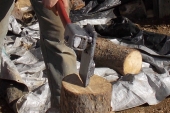




www.thehappypermaculturalist.wordpress.com








































"If we didn't make up problems, when would we use our tools?" -?








John Polk wrote:
If anybody gets one to try, I would caution to be very careful until you get used to the feel. I would imagine that the inertia of the off center handle would try to twist itself out of your hand if you used it as a conventional axe. It could be easy to sprain/break a wrist before you got the "feel" of it.








Devon Olsen wrote:this is some reviews i found, you guys may find them interesting, they were helpful for me:
http://www.hearth.com/econtent/index.php/wiki/Lever_Axe_Reviews/








Devon Olsen wrote:the first link the results weren't perfectly matched because the other guy didnt have a tire, but it was definately faster to split in the first place
so you PERSONALLY knew the guy who did that review and are sure he did it wrong?
i like the axe but would wanna make sure its worth buying before taking the leap given the hard wood i deal with around here...
also i would LOVE to know how fast this thing can chop up a quart of wood, if anyone know an answer or formula








Eric Callahan wrote:A regular single bit or double bit axe of average weight is a more versatile tool and can be used with the same torque to throw the wood apart. This young lady demonstrates quite well, and in green stringy Beech to boot.
http://www.youtube.com/watch?v=7NfCAk4Mj6E
The way I made sense of it and learned was when someone said to actually swing the axe straight down but with the bit at a 30 degree angle. When you hit the billet, it doesnt penetrate/stick and you only need to help it along the rest of the twist, the weight of the poll or opposite bit is already going that way.
"You must be the change you want to see in the world." "First they ignore you, then they laugh at you, then they fight you, then you win." --Mahatma Gandhi
"Preach the Gospel always, and if necessary, use words." --Francis of Assisi.
"Family farms work when the whole family works the farm." -- Adam Klaus




R Scott wrote:And barefoot! http://www.youtube.com/watch?v=7fWo0P0MdJM&feature=channel&list=UL




Tom Allyn wrote:
R Scott wrote:And barefoot! http://www.youtube.com/watch?v=7fWo0P0MdJM&feature=channel&list=UL
A couple things to note in that video. First is that she's using a 'cruiser' axe. That's a relatively light axe, probably not more than 2-1/2 lbs. with a 28"-30" handle, not generally considered a splitting axe. But the twist technique turns it into a great splitter. Also notice that she has intentionally set up much of the wood on rocks. Using the normal splitting technique would ruin the bit of the axe when it broke through the wood and struck the stone. But with the twist technique the force of the blow is converted to sideways splitting energy and the axe stops dead on top the remaining half of the log. No need to buy an expensive single purpose splitting axe when any old axe can do the same thing and much more.
 1
1




On my own property, 100% of my stock for fire-wood is winter-broken Oak branches and fallen trees. I don't cut ANY live trees for wood. The last heavy branch I cut was exactly what you are talking about, large rounds, about 15-16 inches in diameter. I'm using that because that's whats there. Why would anyone else want to cut down a live tree just because it's the right size, when there's broken wood laying there right in front of you?Luke Boyd wrote:As for splitting up giant rounds, ... why?! Smaller trees split easy, dry faster and are less work to drop/drag. Large trees are for timber and boards, branches and baby trees (<10") are for burning.
 1
1





|
Yeah. What he said. Totally. Wait. What? Sorry, I was looking at this tiny ad:
Learn Permaculture through a little hard work
https://wheaton-labs.com/bootcamp
|








